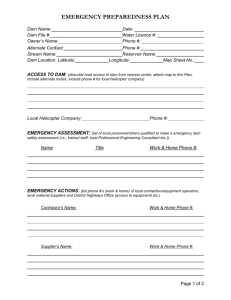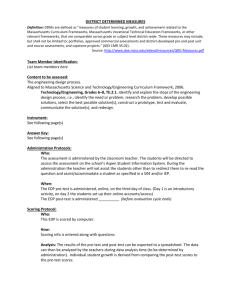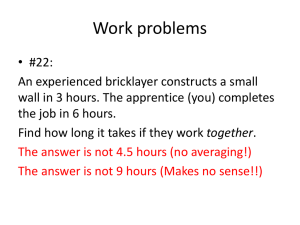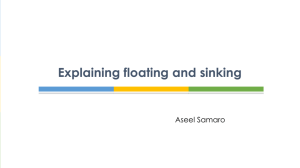Water Works
advertisement
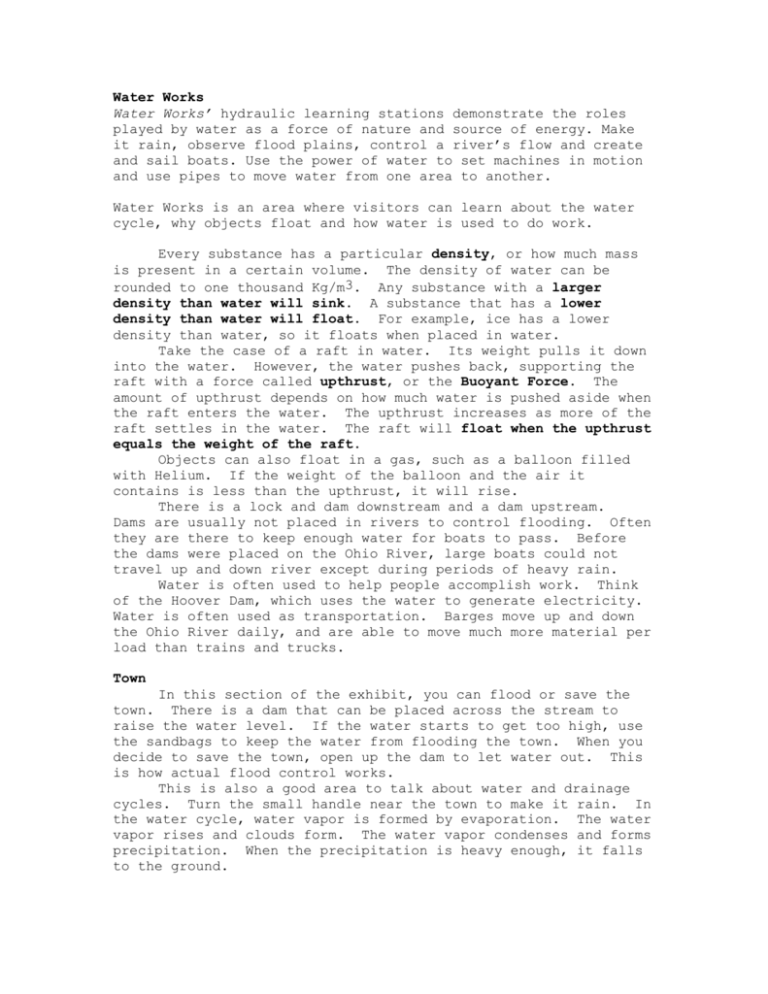
Water Works Water Works’ hydraulic learning stations demonstrate the roles played by water as a force of nature and source of energy. Make it rain, observe flood plains, control a river’s flow and create and sail boats. Use the power of water to set machines in motion and use pipes to move water from one area to another. Water Works is an area where visitors can learn about the water cycle, why objects float and how water is used to do work. Every substance has a particular density, or how much mass is present in a certain volume. The density of water can be rounded to one thousand Kg/m3. Any substance with a larger density than water will sink. A substance that has a lower density than water will float. For example, ice has a lower density than water, so it floats when placed in water. Take the case of a raft in water. Its weight pulls it down into the water. However, the water pushes back, supporting the raft with a force called upthrust, or the Buoyant Force. The amount of upthrust depends on how much water is pushed aside when the raft enters the water. The upthrust increases as more of the raft settles in the water. The raft will float when the upthrust equals the weight of the raft. Objects can also float in a gas, such as a balloon filled with Helium. If the weight of the balloon and the air it contains is less than the upthrust, it will rise. There is a lock and dam downstream and a dam upstream. Dams are usually not placed in rivers to control flooding. Often they are there to keep enough water for boats to pass. Before the dams were placed on the Ohio River, large boats could not travel up and down river except during periods of heavy rain. Water is often used to help people accomplish work. Think of the Hoover Dam, which uses the water to generate electricity. Water is often used as transportation. Barges move up and down the Ohio River daily, and are able to move much more material per load than trains and trucks. Town In this section of the exhibit, you can flood or save the town. There is a dam that can be placed across the stream to raise the water level. If the water starts to get too high, use the sandbags to keep the water from flooding the town. When you decide to save the town, open up the dam to let water out. This is how actual flood control works. This is also a good area to talk about water and drainage cycles. Turn the small handle near the town to make it rain. In the water cycle, water vapor is formed by evaporation. The water vapor rises and clouds form. The water vapor condenses and forms precipitation. When the precipitation is heavy enough, it falls to the ground. As the water falls, point out how the water runs from the land into the stream. More water will flow from the land to the stream if there is inadequate vegetation to soak up the water. Some good questions to ask here are "How can we save the town?" and "How can we flood the town?" Bridge Building In this area try out your construction skills. There is a bridge that is half-finished and we need you to help finish it. When you see the bridge completed, please dismantle it for the next visitor. Boat Building Design a boat at our boat building station and sail it downstream. Use different shapes and experiment with many different designs. A good place to start sailing is above the dam near the town. If the design is not successful, ask why and create a new design. Keep designing and testing until you build a successful boat. Lock and Dam As the boats travel downstream, they come to an area where there is a difference in the water level. There is a system of locks in place to demonstrate how boats travel up and downstream where dams occur. When traveling downstream, the small dam can be opened so the water level downstream rises. When the water levels are equal inside the lock, close the small dam and open the larger dam. The water level drops to the level downstream, and the boat can continue to sail on. Eventually it will come to a white blower, where a gust of wind will continue it on its journey downstream. Two good questions to ask here are: 1) "How can the boat go downstream without going over the waterfall?" and 2) "How can the boat go upstream since it cannot sail up the waterfall?" Water Mechanics Now we come to a series of teamwork activities. On one side of the water table fill the bucket with water. Then a system of ropes and pulleys is used to raise the bucket over the funnel. It is the responsibility of someone on the other side of the water table to dump the water using the rope. It may take a few tries to get the timing down. When successful, the water will travel through the funnel and spin a small turbine, ringing a bell. Here you can ask, "What will happen when the water flows down the funnel?" At the next teamwork activity, a person on one side of the water table turns a wheel to transport water up a conveyor belt. It is the responsibility of a visitor on the other side of the water table to decide if the water will fill a bucket, turn a turbine or fall back into the table. This task is accomplished by turning a wheel. Notice how the gears work on the silver catch basin. Ask "What will happen when the bucket gets full?" or "What will happen when the water hits the pinwheel?" In this area we also find a handle connected to a water spout. When this handle is turned, water will spray from the spout and turn a turbine. This in turn will turn the balls connected to the top of the turbine. People often use water to turn a turbine and generate electricity. Lower Pool The final station is an area where younger kids can use shovels to pick up water and pour into little pinwheel machines. There is plastic pipe that can be connected to valves on the water table. Build different structures to transport the water from one place to another. Using the valves to shut off water flow in one tube will increase the water pressure in another tube. Here you can ask "How can you spin the pinwheel?" or "How can I make this water flow from this tube and spin the pinwheel?" There are many activities you can do in Water Works. After leaving this area we hope you have a better understanding of why some things float and some don't, how the water cycle works, how boats travel up and down river and how water can be used to do work. Knowledge and Skill Development Cognitive o Develop problem-solving skills by testing cause-effect relationships (boat building) o Recognize how water helps accomplish work o Sensory-touch/smell/sound Motor o Boat building, connecting pipes, handles and knobs o Pouring water from container to container o Sensory-touch/smell Social-Emotional o Sense of accomplishment-building with pipes/boats o Cooperative play to operate machines o Responsibility for behavior by following rules and cleaning up o Sympathy for other-flooding o Valuing others-taking turns Curriculum Connections: Ohio–Science: • 4. The learner will select and use appropriate material and tools to construct a useful device. • 2. The learner will discuss the impact of human activity in a selected natural environment. Ohio Fourth Grade Proficiency Outcomes–Science: • 6. Evaluate a simple procedure to carry out an exploration. • 14. Identify and/or describe the relationship between human activity and the environment. Kentucky–Science: • 2.1 Students understand scientific ways of thinking and working and use those methods to solve real-life problems. • 2.3 Students identify and analyze systems and the way their components work together or affect each other. Classroom Connections: Study the water cycle in your classroom. Explore how the water cycle affects communities by investigating hurricanes, floods or tidal waves. Water Works contains an area that can be flooded. Experiment with this idea further in the exhibit or follow up in the classroom with the above activity. Safety tips: The floor is often wet in this exhibit; it is important to walk at all times. There are several “splash zones” where children may get very wet. Aprons thrown on the floor can cause tripping hazards, so please hang your apron up!

